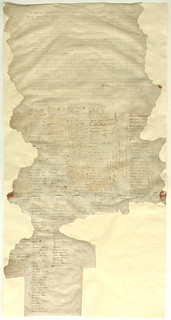In 1841 the Treaty documents were rescued from a fire in the government offices in Auckland. They were then put in an iron safe in the Colonial Secretary’s office in Auckland, and then transferred to Wellington when that city became the capital of New Zealand. Facsimile copies of the Treaty were printed in 1877 and the originals were put into storage.

Hocken rescues the Treaty documents
Early in the 20th century, Thomas Morland Hocken, an elderly physician and historian, discovered the Treaty documents buried in a heap of old papers and rubbish in a basement underneath the wooden Government Buildings in Wellington. They had been damaged by rats and by water. They were restored and then placed in metal containers and stored in the Department of Internal Affairs offices. The Treaty was displayed in public in 1940 for the Centennial celebrations of the signing of the Treaty, and from 1949 was on display in the Alexander Turnbull Library.
Treaty documents move
In 1981 the Treaty documents were placed under the care of the National Archives (now called Archives New Zealand). Between 1991 and 2017 the nine Treaty sheets were displayed in the Constitution Room at Archives New Zealand in Wellington. In May 2017 these were moved to a permanent exhibition space, He Tohu, at National Library of New Zealand, Wellington. The Treaty sheets are all in Māori, except the Waikato sheet.
Recommended resources
- A treaty: Te Tiriti o Waitangi Highlights from National Library's He Tohu exhibition
- Treaty events 1800-49, (Ministry for Culture and Heritage), updated 23-Oct-2014
- Waitangi 175 Archives New Zealand A day-by-day account of the signing of te Tiriti o Waitangi.
- Treaty of Waitangi - Te Tiriti o Waitangi A Treaty of Waitangi chronology with links to the nine treaty sheets that travelled the country. Archives New Zealand.
- Treaty of Waitangi Radio New Zealand explores the history of the Treaty.
- Treaty of Waitangi questions and answers Network Waitangi. [1.5MB PDF]
- Treaty of Waitangi DigitalNZ
